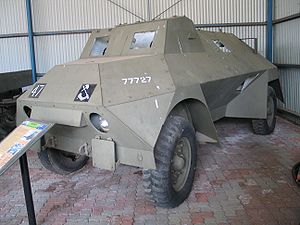- Rover Light Armoured Car
-
Rover Light Armoured Car 
Rover Light Armoured Car in Royal Australian Armoured Corps Tank Museum, Puckapunyal, Victoria, Australia.Type Armoured car Place of origin  Australia
AustraliaSpecifications Weight Mk1 5.2 tonnes, Mk2 5 tonnes Length Mk1 6.1 m, Mk2 5.6 m Width 2.3 m Height 2.1 m Crew 5 (Commander, Driver, 2 Gunners, Wireless operator) Armor 16 mm Main
armament0.303 (7.7 mm) Vickers MMG Secondary
armament0.303 (7.7 mm) Bren LMG Engine Ford V8
95 hp (71 kW)Power/weight 19 hp/tonne Suspension 4x4, leaf spring Operational
rangekm The Light Armoured Car (Aust), also known as Rover, was an armoured car produced in Australia during the Second World War.
Contents
History and description
At the outbreak of World War II the United Kingdom was unable to meet the needs of the Commonwealth for armored fighting vehicles. It led many Commonwealth countries to develop their own AFVs.
The Rover was designed in 1941. It utilized Ford 3-ton CMP truck chassis, either F60L or shorter F60S. The armoured bodies were produced by Ruskin Motor Bodies Pty Ltd of Melbourne. The production was stopped in 1943, a total of 238 cars were built.
The Rover entered service with the Australian army in April 1942. It never saw combat and was used mostly for crew training. A long narrow opening at the top of the hull earned the vehicle a nickname mobile slit trench. Late in 1943 Australia started to receive US-made armoured cars and the Rover was soon declared obsolete.
There are two restored Rover Mk II cars on display in Australian museums, at the National Military Vehicle Museum in Port Adelaide and at the Royal Australian Armoured Corps Tank Museum at Puckapunyal, Victoria.
Variants
- Mk I - F60L chassis (40 units).
- Mk II - F60S chassis (198 units).
References
- Michael K. Cecil - Australian Military Equipment Profiles vol. 3, Australian Scout and Armoured Cars 1933 to 1945, 1993 Australian Military Equipment Profiles, ISBN 0-646-14611-4.
External links
Light tanks Cruiser tanks Mk I · Mk II · Mk III · Mk IV · Mk V Covenanter · Mk VI Crusader · Mk VII Cavalier · Mk VIII Centaur · Mk VIII Cromwell · Challenger · Comet · Sherman Firefly · Ram (Canada) · Grizzly I (Canada) · Sentinel (Australia)Infantry tanks Scout Cars and Armoured carsScout Cars Daimler Dingo • Dingo Scout Car (Australia) • Humber Scout Car • Lynx Scout Car (Canada) • S1 Scout Car (Australia)Light Reconnaissance Cars Armoured Cars AEC Armoured Car • Coventry Armoured Car • Daimler Armoured Car • Fox Armoured Car (Canada) • Guy Armoured Car • Humber Armoured Car • Lanchester Armoured Car • Marmon-Herrington Armoured Car (South Africa) • Morris CS9 • Rhino Heavy Armoured Car (Australia) • Rolls-Royce Armoured Car • Rover Light Armoured Car (Australia) • Standard Beaverette • Armoured Carrier Wheeled Indian Pattern (India)Armoured Trucks Bedford OXA • Armadillo • Bison • C15TA Armoured Truck (Canada) • Leyland Beaver-EelArmoured Command Vehicles Experimental vehiclesAvenger • Black Prince • Centurion • Excelsior • TOG 1 • TOG 2 • Tortoise • Valiant • Harry Hopkins • Alecto • Glanville Fighter Car • Morris Motors Salamander • Hillman Gnat • Schofield tank (New Zealand)Unarmoured vehiclesArtillery tractors Trucks and lorries Bedford QLD • Austin K2 • Morris 15 cwt • Austin K5 • Bedford OYD • Bedford OXD • Morris C9 • Guy Ant • Leyland Retriever (3-ton) • Leyland Lynx (30-cwt) • Leyland Hippo (10-ton) • Thornycroft Nubian • Thornycroft TartarTank transporters Utility and cars British armoured fighting vehicle production during World War II Categories:- Armoured cars of World War II
- World War II armoured fighting vehicles of Australia
Wikimedia Foundation. 2010.

